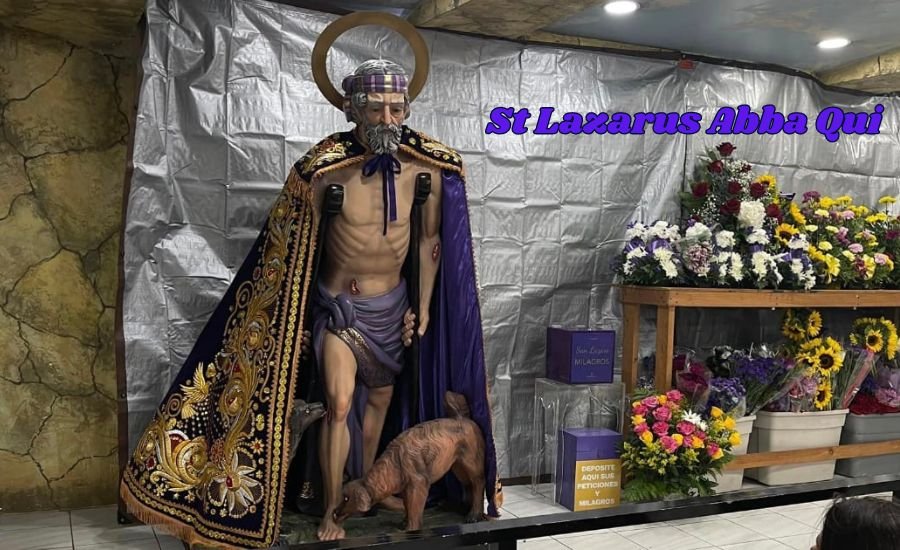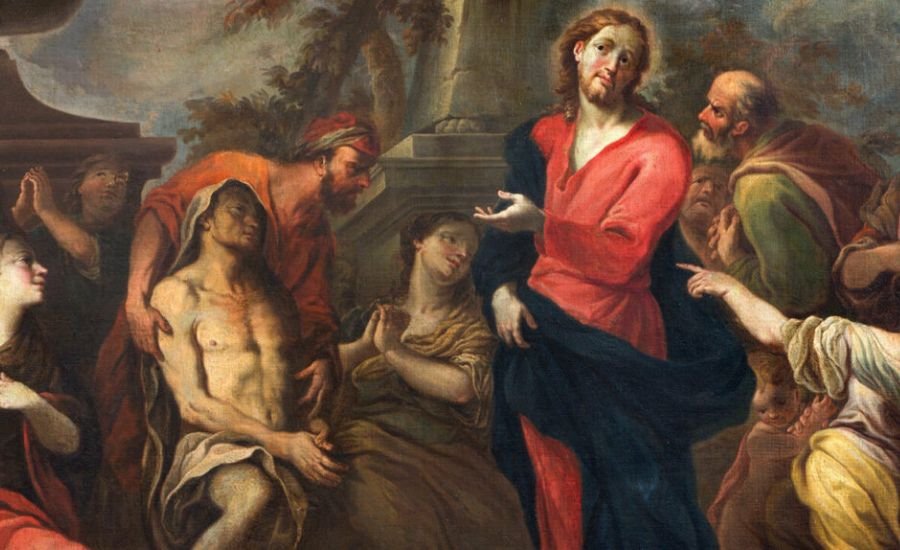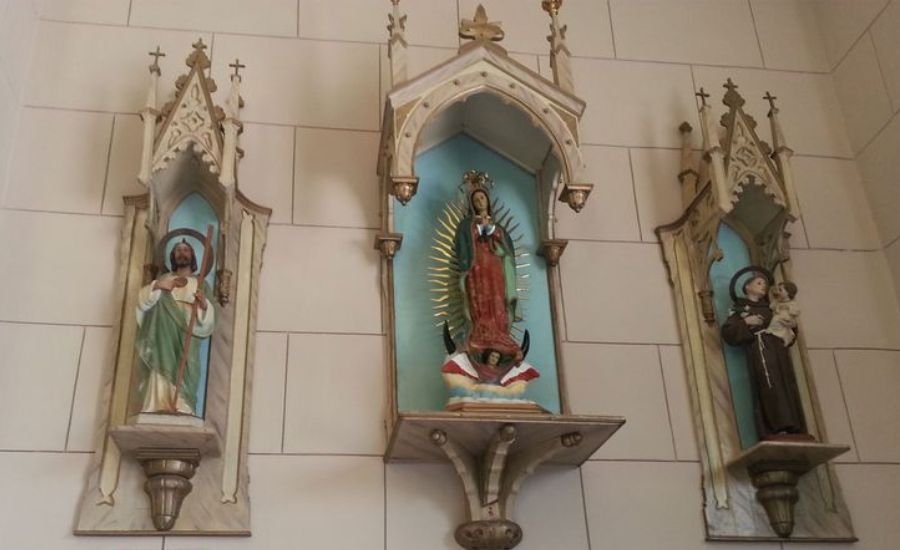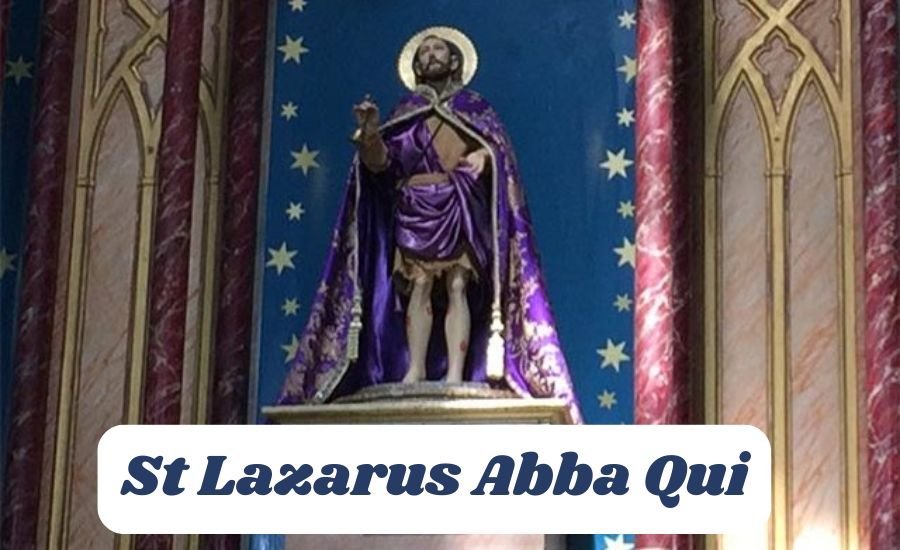St Lazarus Abba Qui is a special figure in many people’s lives, especially in Cuba. This important person is known for his healing powers and his connection to the religion of Santería. If you’ve ever heard about St. Lazarus Abba Qui, you might wonder who he is and why he matters so much to people.
In this blog post, we will dive into the world of St. Lazarus Abba Qui. We’ll look at his background, why people respect him, and how he helps those in need. So, let’s start exploring and learn more about this fascinating figure.
What is St lazarus abba qui ?
St lazarus abba qui is a special figure in Cuban culture, blending elements of the biblical Saint Lazarus with the Yoruba deity Babalu Aye. He is honored in both Santería and Catholic traditions, making him a unique and important part of Cuban life. St. Lazarus Abba Qui is known for his healing abilities and is seen as a protector for those suffering from illness.
In Cuban culture, he is more than just a religious figure; he represents hope and resilience. People from various backgrounds, not just those who practice Santería, respect and seek his help. His significance stretches beyond religious boundaries, highlighting his role as a universal symbol of healing and comfort. His story and the devotion towards him are deeply rooted in Cuban traditions and reflect the blending of different cultural and religious influences.
St lazarus abba qui presence in Cuban society underscores how various traditions can come together to form something meaningful. His importance is a testament to the rich cultural tapestry of Cuba and the way spirituality can unite people from different walks of life.
The Role of St lazarus abba qui in Santería

In the Afro-Cuban religion of Santería, St lazarus abba qui is known as Babalu Aye. Santería combines Yoruba religious beliefs from Africa with Catholic elements from the colonial era. Babalu Aye is a major deity in this religion, celebrated for his powerful healing abilities and his role as a protector. He is often depicted as an old man with crutches, symbolizing both his suffering and his capacity to aid those in need.
Babalu Aye’s role in Santería is central to the religion’s practices. Followers believe that he can heal diseases, particularly those related to the skin and bones. They turn to him in times of illness, seeking his intervention for recovery. His imagery, often accompanied by two dogs, reinforces his connection to care and loyalty, emphasizing the compassion he offers to those who are sick.
This syncretism of Yoruba and Catholic traditions highlights how religious practices can evolve and blend over time. St lazarus abba qui role in Santería shows the adaptation of African spiritual practices into the Caribbean context, creating a unique form of worship that is both deeply spiritual and culturally significant.
How St lazarus abba qui is Celebrated in Cuba
In Cuba, St lazarus abba qui is celebrated with great fervor, especially on December 17th, known as his Feast Day. This day is marked by large gatherings and pilgrimages, particularly to the Church of El Rincón near Havana. People from all over the island travel to this site to pay their respects, seek blessings, and show their devotion.
The celebration is a vibrant mix of religious and cultural practices. Many pilgrims make the journey on foot, with some walking barefoot or on their knees as a form of penance and respect. This act of devotion reflects the deep faith people have in St. Lazarus Abba Qui’s ability to bring healing and comfort. The Feast Day is not only a time for religious observance but also a community event filled with music, food, and social gatherings.
The way St lazarus abba qui is celebrated highlights his importance in Cuban culture. The devotion displayed on his Feast Day demonstrates the strong connection between the people and their spiritual practices, showcasing how traditions can shape and enrich community life.
The Pilgrimage to El Rincón
The pilgrimage to El Rincón is one of the most significant events in the devotion to St lazarus abba qui Each year on December 17th, thousands of devotees make their way to the Church of El Rincón, located near Havana. This pilgrimage is a powerful expression of faith, with many people traveling long distances to participate. Some even undertake the journey barefoot or on their knees, reflecting their deep reverence and commitment.
This annual event is not only a religious practice but also a cultural phenomenon. The pilgrimage brings together people from various parts of Cuba, creating a sense of unity and shared purpose. It’s a time for personal reflection, gratitude, and communal celebration. The journey to El Rincón symbolizes the dedication of the devotees and their belief in St lazarus abba qui power to heal and protect.
The pilgrimage to El Rincón is a testament to the enduring significance of St lazarus abba qui in Cuban culture. It highlights the ways in which religious practices can foster community and strengthen cultural identity.
Devotional Practices for St lazarus abba qui
Devotional practices for St. Lazarus Abba Qui involve various rituals and offerings. Devotees commonly present candles, flowers, food, and cigars as symbols of their respect and requests for assistance. These offerings are made in hopes of receiving blessings and protection from the saint. Many people also make promises, known as promesas, to St lazarus abba qui , which they fulfill if their requests are granted.
These practices are deeply rooted in the tradition of showing gratitude and devotion. The act of making offerings and fulfilling promises reflects the strong connection that followers feel towards St. Lazarus Abba Qui. It’s a way of honoring his role as a healer and protector while actively participating in his spiritual care.
The rituals associated with St lazarus abba qui also serve to strengthen the sense of community among his devotees. By coming together to perform these practices, people reinforce their shared beliefs and support one another in their spiritual journeys.
The Symbolism of Dogs in St lazarus abba qui Worship

In the worship of St. Lazarus Abba Qui, dogs hold significant symbolic meaning. He is often depicted with two dogs, which represent loyalty, protection, and compassion. This imagery underscores the idea that even those who are suffering and marginalized deserve care and attention.
The presence of dogs in the depictions of St. Lazarus Abba Qui highlights his role as a protector and his connection to those in need. In Cuban culture, dogs are seen as loyal companions, making this symbolism particularly powerful. It reflects the deep empathy and support that St. Lazarus Abba Qui provides to his followers.
This symbolism also reinforces the broader message of kindness and compassion within the devotion to St. Lazarus Abba Qui. It serves as a reminder of the importance of caring for others, especially those who are struggling or in need of help.
The Blend of Catholicism and Santería in St lazarus abba qui
The veneration of St. Lazarus Abba Qui is a prime example of how Catholicism and Santería blend together. St. Lazarus Abba Qui combines the Catholic Saint Lazarus with the Yoruba deity Babalu Aye. This fusion creates a unique religious figure that embodies aspects of both traditions.
In Catholicism, St. Lazarus is known as a beggar who received help from Jesus. In Santería, Babalu Aye is a deity associated with healing and protection. The blending of these traditions reflects the rich cultural and religious history of Cuba, where different beliefs have come together to form a new practice.
This blend of Catholicism and Santería is evident in the rituals, symbols, and imagery associated with St. Lazarus Abba Qui. It showcases the adaptability of religious practices and highlights the way different cultural influences can merge to create something meaningful and new.
The Importance of Respect and Humility in Worshipping St lazarus abba qui
Respect and humility are central to the worship of St. Lazarus Abba Qui. Devotees approach him with sincere hearts, seeking his help and blessings. This attitude of respect is essential for receiving his assistance and protection.
Approaching St. Lazarus Abba Qui with humility means acknowledging one’s own needs and showing gratitude for the help received. It reflects the broader values of humility and sincerity that are important in both Santería and Catholicism. This respectful approach is seen as a way of honoring St. Lazarus Abba Qui’s role and ensuring a meaningful connection with him.
The emphasis on humility in worship highlights the importance of having a pure heart and good intentions. It reinforces the idea that spiritual practices should be grounded in genuine respect and a sincere desire for help and healing.
How St lazarus abba qui Influences Modern Cuban Society
St. Lazarus Abba Qui has a significant impact on modern Cuban society. His influence is felt in the way people seek his help during difficult times and how they turn to him for guidance and support. His role as a healer and protector makes him a vital figure in the lives of many Cubans.
In contemporary Cuban society, St. Lazarus Abba Qui symbolizes hope and resilience. His teachings and traditions continue to inspire people as they navigate challenges and hardships. The influence of St. Lazarus Abba Qui is a testament to his enduring relevance and the strength of his cultural and spiritual significance.
His presence in modern Cuban life underscores the ongoing importance of spiritual practices and the ways in which they help people cope with their everyday struggles. St. Lazarus Abba Qui’s influence is a reminder of the power of faith and tradition in shaping and supporting community life.
The Connection Between St lazarus abba qui and Health

St. Lazarus Abba Qui is closely connected to health and healing. Many people turn to him for help with illnesses and health issues. Devotees believe that he has the power to bring relief and recovery, making him a central figure in their health-related prayers and rituals.
His association with health is reflected in the rituals performed by his followers. They offer prayers, make promises, and participate in traditional practices to seek his assistance. Some people attribute their healing to St. Lazarus Abba Qui, reinforcing his role as a powerful healer.
The belief in St. Lazarus Abba Qui’s ability to influence health highlights the importance of spiritual support in dealing with physical ailments. His connection to health and healing is a key aspect of his worship and a reason why he is so deeply revered by his followers.
Social and Cultural Events Celebrating St lazarus abba qui
The Feast Day of St. Lazarus Abba Qui is not just a religious event but also a vibrant social and cultural celebration. On December 17th, the streets around the Church of El Rincón come alive with music, dancing, and communal activities. The celebration is a blend of spiritual observance and cultural festivity.
During this day, people gather to share food, participate in traditional dances, and enjoy the festive atmosphere. It’s a time for the community to come together, strengthening social bonds and celebrating their shared faith. The cultural events that accompany the Feast Day highlight the rich traditions associated with St. Lazarus Abba Qui.
These celebrations are an important part of maintaining cultural identity and passing on traditions. They reflect the way religious and cultural practices can blend to create meaningful and joyful experiences for the community.
The Global Reach of St lazarus abba qui Devotion
St. Lazarus Abba Qui’s influence extends beyond Cuba to Cuban communities around the world. In places like Miami, his devotion remains strong among the Cuban diaspora. This global reach demonstrates the widespread impact of his teachings and the continued relevance of his role.
The global devotion to St. Lazarus Abba Qui reflects the way cultural and religious practices travel and adapt in new environments. Cuban communities abroad continue to celebrate and honor him, maintaining their connection to their heritage and spiritual traditions.
This international aspect of St. Lazarus Abba Qui’s worship highlights the enduring appeal of his message. It shows how spiritual practices can transcend borders and remain important to people, no matter where they live.
Be sure to know: Husqvarna 517203204
St lazarus abba qui and Other Religious Traditions
St. Lazarus Abba Qui shares similarities with other religious traditions, reflecting a broader pattern of veneration and spiritual practices. In Catholicism, the worship of saints often involves asking for their intercession and help. Similarly, in Afro-Cuban religions, deities and spirits are honored for their ability to provide guidance and support.
The connection between St. Lazarus Abba Qui and other religious figures shows how spiritual practices can intersect and influence each other. This blending of traditions highlights the diversity of religious expressions and the ways in which different beliefs can come together.
Understanding these connections provides insight into the broader context of religious worship and the shared values that underpin various spiritual practices. It emphasizes the universal aspects of devotion and the ways in which people seek support and guidance from their spiritual beliefs.
The History of St lazarus abba qui in Afro-Cuban Religions

The history of St. Lazarus Abba Qui in Afro-Cuban religions is a fascinating blend of African and Catholic influences. Originally a figure in Yoruba religion, Babalu Aye was integrated into Santería as St. Lazarus Abba Qui. This fusion represents the adaptation of African spiritual practices to the Caribbean context.
The development of St. Lazarus Abba Qui’s role in Afro-Cuban religions reflects the historical interactions between African slaves and colonial powers. Over time, these interactions led to the creation of new religious practices that incorporated elements from both traditions.
Studying this history provides valuable insight into the ways in which religious practices evolve and adapt. It highlights the creative and resilient nature of spiritual traditions as they respond to changing cultural and historical contexts.
How St lazarus abba qui Teachings are Applied in Daily Life
The teachings of St. Lazarus Abba Qui are applied in daily life through various practices and rituals. Followers use his teachings to guide their actions and decisions, especially in times of difficulty. His emphasis on healing and protection influences how people approach their everyday challenges.
Devotees often turn to St. Lazarus Abba Qui for advice and support, incorporating his teachings into their personal and communal lives. His role as a healer extends beyond religious rituals, impacting how people handle issues related to health, well-being, and interpersonal relationships.
The application of St. Lazarus Abba Qui’s teachings demonstrates the practical impact of spiritual beliefs on daily life. It shows how religious practices can provide comfort and guidance in various aspects of life, helping people navigate their experiences with faith and resilience.
The Future of St lazarus abba qui Worship
The future of St. Lazarus Abba Qui’s worship looks promising as traditions continue to evolve. New generations are likely to maintain and adapt the practices associated with him, ensuring that his influence remains strong. The ongoing devotion to St. Lazarus Abba Qui reflects his enduring significance and the continued relevance of his teachings.
As cultural and religious practices evolve, the way people honor St. Lazarus Abba Qui may change, but his core message of healing and protection will likely persist. This adaptability ensures that his worship remains a vital part of both traditional and contemporary spiritual practices.
The future of St. Lazarus Abba Qui’s worship highlights the dynamic nature of religious traditions. It underscores the ways in which spiritual practices can evolve while still preserving their essential values and significance.
Conclusion
St lazarus abba qui is a deeply important figure in Cuban culture and spirituality. His role as a healer and protector brings comfort and hope to many people. Through celebrations, rituals, and his unique blend of Catholic and Afro-Cuban traditions, he continues to inspire devotion and respect.
As we look to the future, the worship of St. Lazarus Abba Qui will likely continue to grow and adapt. His teachings and the way he is honored reflect the rich cultural tapestry of Cuba. Whether through festivals or daily practices, his influence remains strong and meaningful.
Get More Information: 1023 dewey ave ne unit c rental
FAQs
Q: Who is St lazarus abba qui ?
A: St. Lazarus Abba Qui is a blend of the biblical Saint Lazarus and the Yoruba deity Babalu Aye, honored in both Santería and Catholic traditions for his healing powers.
Q: When is St lazarus abba qui Feast Day?
A: St. Lazarus Abba Qui’s Feast Day is on December 17th, a significant day of celebration and pilgrimage in Cuba.
Q: What is the significance of dogs in St. Lazarus Abba Qui’s worship?
A: Dogs are symbols of loyalty and protection in the worship of St. Lazarus Abba Qui, often depicted with him to emphasize his caring nature.
Q: How do people celebrate St lazarus abba qui i in Cuba?
A: People celebrate by participating in pilgrimages to El Rincón, making offerings, and joining in cultural festivities and communal activities.
Q: What are common offerings to St lazarus abba qui ?
A: Common offerings include candles, flowers, food, and cigars, which are made as symbols of respect and requests for blessings.
Q: How does St lazarus abba qui influence health?
A: Many believe that St. Lazarus Abba Qui has the power to heal and protect from illness, making him a central figure in prayers for health.
Q: Where is the Church of El Rincón located?
A: The Church of El Rincón is near Havana, Cuba, and is a key site for pilgrimages and celebrations of St. Lazarus Abba Qui.
